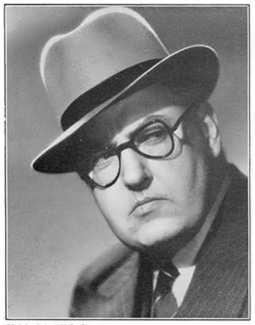
John Grierson was a Scottish documentary maker, often considered the father of British and Canadian documentary film. In 1926, Grierson coined the term "documentary" in a review of Robert J. Flaherty's Moana. In 1939, Grierson established the all-time Canadian film institutional production and distribution company The National Film Board of Canada controlled by the Government of Canada.

William Norman McLaren, LL. D. was a Scottish Canadian animator, director and producer known for his work for the National Film Board of Canada (NFB). He was a pioneer in a number of areas of animation and filmmaking, including hand-drawn animation, drawn-on-film animation, visual music, abstract film, pixilation and graphical sound. McLaren was also an artist and printmaker, and explored his interest in dance in his films.

Sabu Dastagir was an Indian actor who later gained United States citizenship. Throughout his career he was credited under the name Sabu and is primarily known for his work in films during the 1930s–1940s in Britain and the United States. He was inducted into the Hollywood Walk of Fame in 1960.

Hidden Agenda is a 1990 political thriller film directed by Ken Loach with a screenplay by Jim Allen. The film stars Frances McDormand, Brian Cox, Brad Dourif, Maurice Roëves, Ian McElhinney, Mai Zetterling and Michelle Fairley. The plot follows the investigation of a killing in Northern Ireland by British security forces.

Basil Charles Wright was an English documentary filmmaker, film historian, film critic and teacher.
Barney Platts-Mills was a British film director, best known for his award-winning films, Bronco Bullfrog and Private Road.

The Gentle Sex is a 1943 British black-and-white romantic comedy-drama war film, directed by Leslie Howard and Maurice Elvey and narrated by Howard. It was produced by Concanen Productions, Two Cities Films, and Derrick de Marney. It was Howard's last film before his death.

Percy Marmont was an English film actor.

Brandy for the Parson is a 1952 British comedy film directed by John Eldridge and starring Kenneth More, Charles Hawtrey, James Donald and Jean Lodge. It was written by Walter Meade, John Dighton and Alfred Shaughnessy based on a short story by Geoffrey Household from Tales of Adventurers (1952). The title is a reference to the refrain of the poem "A Smuggler's Song" by Rudyard Kipling.

No Orchids for Miss Blandish is a 1948 British gangster film adapted and directed by St. John Legh Clowes from the 1939 novel of the same name by James Hadley Chase. It stars Jack La Rue, Hugh McDermott, and Linden Travers, with unbilled early appearances from Sid James, as a barman, and Walter Gotell, as a nightclub doorman.

Charles Goldner was an Austrian-born actor who appeared in a number of British films during the 1940s and 1950s. Born in Vienna, Austria, on 7 December 1900, he made his screen debut in the 1940 film Room for Two and went on to appear in Brighton Rock, No Orchids for Miss Blandish, Bond Street and The Captain's Paradise. His stage work included starring in the 1954 Broadway musical The Girl in Pink Tights. He died on 15 April 1955 in London, England.

Stuart Legg was a pioneering English documentary filmmaker. At the 14th Academy Awards in 1941, Legg's National Film Board of Canada film Churchill's Island became the first-ever documentary to win an Oscar.

The Brave Don't Cry is a 1952 British drama film directed by Philip Leacock and starring John Gregson, Meg Buchanan and John Rae. The film depicts the events of September 1950 at the Knockshinnoch Castle colliery in Scotland, where 129 men were trapped by a landslide. It was shot at Southall Studios and was also known by the alternative title Knockshinnoch Story. The filmmakers used actors from the Glasgow Citizens Theatre. It was screened at the Venice Film Festival in September 1952.

No Orchids for Miss Blandish is a 1939 crime novel by the British writer James Hadley Chase. It was a critical and commercial success upon release, though it also provoked considerable controversy due to its explicit depiction of sexuality and violence. In 1942, the novel was adapted into a stage play and in 1948 it became a British film. The novel became particularly popular with British servicemen during World War II.

You're Only Young Twice is a 1952 British second feature ('B') comedy film directed by Terry Bishop and starring Duncan Macrae, Joseph Tomelty, Patrick Barr, Charles Hawtrey and Diane Hart. It was written by Reginald Beckwith, Bishop and Lindsay Galloway based on the 1939 play What Say They? by James Bridie.

Tempean Films was a British film production company formed in 1948 by Robert Baker and Monty Berman. Tempean's output of B movies were distributed by Eros Films. The company later moved into television, adapting Leslie Charteris' series of The Saint novels, starring Roger Moore.

Minnie Malinda "Nan" Braunton was a British actress who had a prolific stage career during the 1930s and 1940s but who is best remembered for playing Cissy Godfrey in the BBC comedy Dad's Army.
Donald Alexander (1913–1993) was a British documentary film-maker who worked as producer, director, writer and editor of films documenting social and industrial conditions, most notably in the coal-mining industry, between the 1930s and 1970s. The movement of which he was part is now regarded as the golden age of British documentary. Its leading figures also included Paul Rotha, John Grierson, Edgar Anstey, Humphrey Jennings, Basil Wright and Arthur Elton.

MacDonald Parke (1891–1960) was a Canadian film and television actor. He frequently portrayed American characters in British films such as No Orchids for Miss Blandish.
John Eldridge (1917–1962) was a short-lived British film director.





















